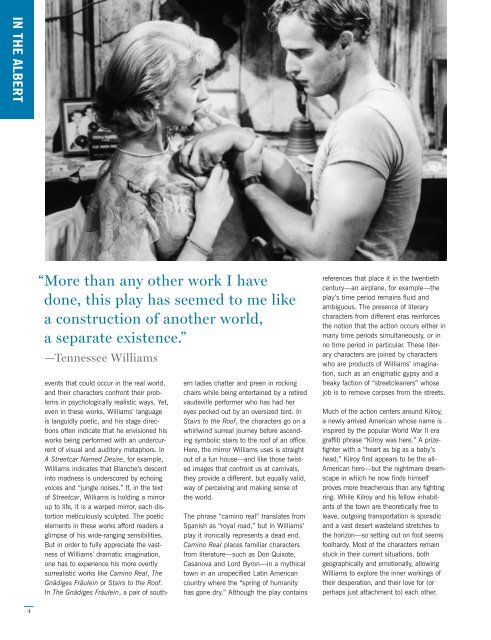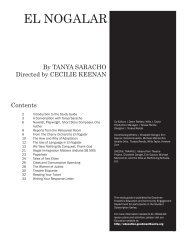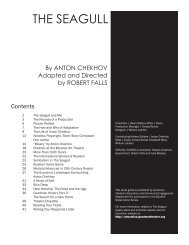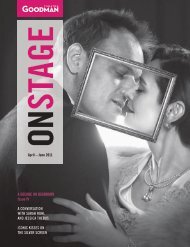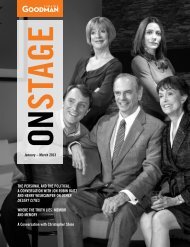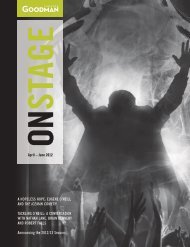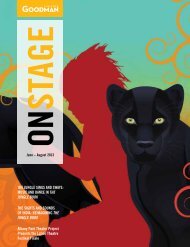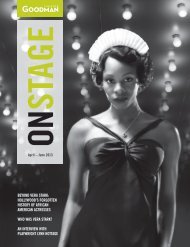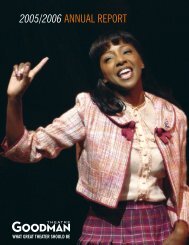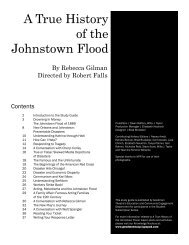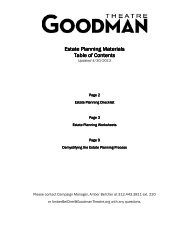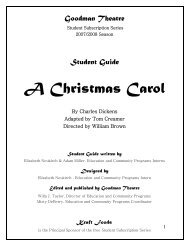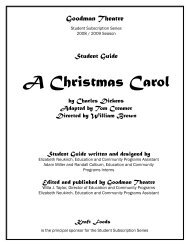Download - Goodman Theatre
Download - Goodman Theatre
Download - Goodman Theatre
You also want an ePaper? Increase the reach of your titles
YUMPU automatically turns print PDFs into web optimized ePapers that Google loves.
IN THE ALBERT<br />
“More than any other work I have<br />
done, this play has seemed to me like<br />
a construction of another world,<br />
a separate existence.”<br />
—Tennessee Williams<br />
events that could occur in the real world,<br />
and their characters confront their problems<br />
in psychologically realistic ways. Yet,<br />
even in these works, Williams’ language<br />
is languidly poetic, and his stage directions<br />
often indicate that he envisioned his<br />
works being performed with an undercurrent<br />
of visual and auditory metaphors. In<br />
A Streetcar Named Desire, for example,<br />
Williams indicates that Blanche’s descent<br />
into madness is underscored by echoing<br />
voices and “jungle noises.” If, in the text<br />
of Streetcar, Williams is holding a mirror<br />
up to life, it is a warped mirror, each distortion<br />
meticulously sculpted. The poetic<br />
elements in these works afford readers a<br />
glimpse of his wide-ranging sensibilities.<br />
But in order to fully appreciate the vastness<br />
of Williams’ dramatic imagination,<br />
one has to experience his more overtly<br />
surrealistic works like Camino Real, The<br />
Gnädiges Fräulein or Stairs to the Roof .<br />
In The Gnädiges Fräulein, a pair of southern<br />
ladies chatter and preen in rocking<br />
chairs while being entertained by a retired<br />
vaudeville performer who has had her<br />
eyes pecked out by an oversized bird. In<br />
Stairs to the Roof, the characters go on a<br />
whirlwind surreal journey before ascending<br />
symbolic stairs to the roof of an office.<br />
Here, the mirror Williams uses is straight<br />
out of a fun house—and like those twisted<br />
images that confront us at carnivals,<br />
they provide a different, but equally valid,<br />
way of perceiving and making sense of<br />
the world.<br />
The phrase “camino real” translates from<br />
Spanish as “royal road,” but in Williams’<br />
play it ironically represents a dead end.<br />
Camino Real places familiar characters<br />
from literature—such as Don Quixote,<br />
Casanova and Lord Byron—in a mythical<br />
town in an unspecified Latin American<br />
country where the “spring of humanity<br />
has gone dry.” Although the play contains<br />
references that place it in the twentieth<br />
century—an airplane, for example—the<br />
play’s time period remains fluid and<br />
ambiguous. The presence of literary<br />
characters from different eras reinforces<br />
the notion that the action occurs either in<br />
many time periods simultaneously, or in<br />
no time period in particular. These literary<br />
characters are joined by characters<br />
who are products of Williams’ imagination,<br />
such as an enigmatic gypsy and a<br />
freaky faction of “streetcleaners” whose<br />
job is to remove corpses from the streets.<br />
Much of the action centers around Kilroy,<br />
a newly arrived American whose name is<br />
inspired by the popular World War II era<br />
graffiti phrase “Kilroy was here.” A prizefighter<br />
with a “heart as big as a baby’s<br />
head,” Kilroy first appears to be the all-<br />
American hero—but the nightmare dreamscape<br />
in which he now finds himself<br />
proves more treacherous than any fighting<br />
ring. While Kilroy and his fellow inhabitants<br />
of the town are theoretically free to<br />
leave, outgoing transportation is sporadic<br />
and a vast desert wasteland stretches to<br />
the horizon—so setting out on foot seems<br />
foolhardy. Most of the characters remain<br />
stuck in their current situations, both<br />
geographically and emotionally, allowing<br />
Williams to explore the inner workings of<br />
their desperation, and their love for (or<br />
perhaps just attachment to) each other.<br />
4


